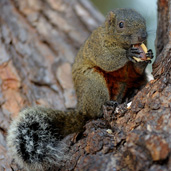Bibliographie relative à l'Écureuil de Corée
Ai, C., Qiu, G., Shi, Z., Wu, X., Liu, X. & Zhao, J. 1991. Host associations and seasonal abundance of immature Ixodes persulcatus (Acari : Ixodidae) in a Lyme disease-endemic area in China. Exp. Appl. Acarol. 12: 251-257.
Amori, G. & Gippoliti, S. 1995. Siberian chipmunk Tamias sibiricus in Italy. Mammalia, 59: 288-289.
Azakawa, M. 2005. Perspectives of host-parasite relationships between rodents and nematodes in Japan. Mammal Study 30: S95–S99.
Bannikov, A.G. 1954. [Mammals of the Mongolian Peoples' Republic]. Moscow: Izdatelstvo Akademii Nauk SSSR, 669 pp. In Russian.
Beaucournu, J.-C., Pisanu, B. & Chapuis, J.-L. 2008. Enderleinellus tamiasis Fahrenholz, 1916 (Anoplura : Enderleinellidae), espèce importée, implantée et nouvelle pour la Faune de France. Parasite 15: 175-178.
Berger, M. 1984. Streifenhörnchen, Burunduk - Tamias sibiricus (Laxmann, 1769). Pp. 155-159, In: R. Schröpfer, R. Feldmann & H. Vierhaus (Hrsg.), Die Säugetiere Westfalens, Münster, S.
Bertolino, S. 2009. Animal trade and non-indigenous species introduction: the world-wide spread of squirrels. Diversity and Distribution 15: 701-708.
Bertolino, S., Currado, I., Mazzoglio, P.J. & Amori, G. 2000. Native and alien squirrels in Italy. Hystrix It. J. Mamm. 11: 49-58.
Bertolino, S. & Genovesi, P. 2005. The application of the European strategy on invasive alien species: an example with introduced squirrels. Hystrix It. J. Mamm. (n.s.) 16: 59-69.
Blake, B.H. & Gillett, K.E. 1988. Estrous cycle and related aspects of reproduction in captive Asian chipmunks, Tamias sibiricus. J. Mamm. 69: 598-603.
Blake, B.H. 1992. Estrous calls in captive Asian chipmunks, Tamias sibiricus. J. Mamm., 73, 597-603.
Bonnet, S., Choumet, V., Masseglia, S., Cotte, M., Ferquel, E., Lilin, T., Marsot, M., Chapuis, J.-L., Vourc'h, G. (2015). Infection of Siberian chipmunks (Tamias sibiricus barberi) with Borrelia sp. reveals a low reservoir competence under experimental conditions. Ticks and Tick-borne Diseases 6: 393-400.
Boyer, N., Réale, D., Marmet, J., Pisanu, B. &. Chapuis, J.-L. 2010. Temperament, space use and tick load in a introduced population of Siberian chipmunk, Tamias sibiricus, introduced in a French suburban forest. J. Animal Ecol. 79 : 538-547.
Chapuis, J.-L. 2005. Répartition en France d'un animal de compagnie naturalisé, le Tamia de Sibérie (Tamias sibiricus). Rev. Ecol. (Terre Vie) 60 : 239-253.
Chapuis, J.-L., Ferquel, E., Patey, O., Vourc’h, G. & Cornet, M. (2010). Borréliose de Lyme : situation générale et conséquences de l’introduction en Ile-de-France d’un nouvel hôte, le tamia de Sibérie. Bulletin épidémiologique hebdomadaire, Hors-série, 14 sept. 2010, 6-8.
Chapuis, J.-L., Gerriet, O., Losinger-Chabod, I. & Pisanu, B. 2018. Gestion d'espèces exotiques envahissantes : le cas des écureuils en France. Revue Faune Sauvage (ONCFS), n°321, 45-51.
Chapuis, J.-L., Obolenskaya, E., Pisanu, B. & Lissovsky, A. (2011). Datasheet on Tamias sibiricius. CABI, Wallingford, UK. http://www.cabi.org/isc.
Chernyavskiy, F.B. 1984. [Mammals of extreme North-East of Siberia]. Moscow: Nauka, 388 pp. [In Russian].
Dal Farra, A., Cassol M. & Lapini L., 1996. Status del Burunduk (Tamias sibiricus [Laxmann, 1769], Rodentia, Sciuridae) nel Bellunese (Italia Nord-Orientale). Boll. Mus. civ. St. nat. Venezia 45: 189-193.
Dijkstra, V. & Dekker, J. 2008. Risico-assessment uitheems eekhoorns. VZZ rapport 2008.10. Zoogdiervereniging VZZ, Arnhem.
Dozières, A. 2008. Conséquences de l’introduction du tamia de Sibérie (Tamias sibiricus) en forêt de Sénart (Essonne). Relations tamia-rongeurs et tamia-borréliose de Lyme. Rapport Master 2, EBE, Univ. Paris Sud-11/MNHN, 42 p.
Durden, L.A. & Musser, G.G. 1994a. The sucking lice (Insecta, Anoplura) of the world: a taxonomic checklist with records of Mammalian hosts and geographical distribution. Bull. Am. Mus. Nat. Hist. 218, 1–90.
Durden, L.A. & Musser, G.G. 1994b. The mammalian Hosts of the Sucking Lice (Anoplura) of the world: a host-parasite List. Bulletin of the Society of Vector Ecology 19, 130-168.
Durette-Desset, M.-C. 1970. Brevistriata bergerardi, nouveau Nématode Héligmosome, parasite d’un écureuil de Corée. Bull. Mus. Natn. Hist. Nat. 42 : 419–423.
Durette-Desset, M.-C. 1976. Brevistriatinae (Nematoda: Heligmosomidae) I. Compléments morphologiques à l’étude d’espèces connues. Bull. Mus. Natn. Hist. Nat. 270: 685-692.
Ellerman, J.R. & Morison-Scott, T.C.S. 1951. Checklist of Palaearctic and Indian Mammals 1758 to 1946. London, UK: Printed by order of the Trustees of the British Museum, 810 pp.
Elshanskaya, N.I., & Popov, M.N. 1972. [Zoologico-parasitological characteristics of the river Kenkeme valley (Central Yakutia)]. Theriology 1 : 368-373. In Russian
Fernandez, H. 1995. Tamias sibiricus (Laxmann, 1769). Pp. 236-238, in J. Hausser (ed.), Mammifères de la Suisse. Répartition, biologie, écologie. Commission des mémoires de l'Académie suisse des sciences naturelles, Birkhäuser Verlag, Basel.
Formozov, A.N. 1928. [About peculiarities of ranges of Russian dormice (Myoxidae) and chipmunks (Eutamias sibiricus, Gmel)]. Bulletin Moskovskogo Obshchestva Ispytateley Prirody 37: 205–204 [In Russian].
Forstmeier, W. & Weiss, I. 2002. Effects of nest predation in the Siberian chipmunk Tamias sibiricus on success of the dusky warbler Phylloscopus fuscatus breeding. Zoologichesky Zhurnal 81: 1367-1370 [in Russian].
Forstmeier, W. & Weiss, I. 2004. Adaptive plasticity in nest-site selection in response to changing predation risk. Oikos 104: 487-499.
Geinitz, C. 1980. Beiträge zur Biologie des Streifen-hörnchens (Eutamias sibiricus Laxmann, 1769) auf einem Friedhof in Freiburg (Süddeutschland). Z. Säugetierkunde 45: 279-287.
Gromov, I.M. & Erbaeva, M.A. 1995. [The Mammals of the Russia and adjacent territories (Lagomorphs and Rodents)]. St. Peterburg: Izdatelstvo RAN, 522 pp. [in Russian].
Hahm, S. & Lew, J. (1976) Cytogenetic studies of the Korean Chipmunk, Eutamias sibiricus asiaticus. Yonsei Medical Journal 17: 39-45.
Huang, H., Ding, Z., He, J., Wu, X., Jiang, B., Gao, Y., Zhao, Q., Wang, Y. & Cao, W. 2006. [Investigation on Borrelia burgdorferi infection in ticks and animal from a forest area of Jilin province]. Chinese Journal of Zoonoses 22, 785-788 [in Chinese, English summary].
Hurková, L., Hajdusek, O., Modry, D. 2003. Natural infection of Cryptosporidium muris (Apicomplexa: Cryptosporiidae) in Siberian chipmunks. Journal of Wildlife Diseases 39: 441-444.
Inoue, K., Maruyama, S., Kabeya, H., Hagiya, K., Izumi, Y., Une, Y., Yoshikawa, Y. (2009). Exotic small mammals as potential reservoirs of zoonotic Bartonella spp. Emerging Infectious Diseases 15: 526-532.
Jaeger, R. 1974. Die unterschieldliche Dauer von Schalf- und Wachphasen während einer Winterschlafperiode des Burunduk, Tamias (Eutamias) sibiricus Laxmann, 1796. Z. Säugetierkunde 39: 10-15.
Jaouen, Y. & Léger, F. 2005. Signalements du Tamia de Sibérie Tamias sibiricus dans le département de la Somme. Arvicola 17 : 8.
Kawamichi, M. 1980. Food, food hoarding and seasonal changes of Siberian chipmunks. Jpn. J. Ecol. 30: 211-220.
Kawamichi, M. 1989. Nest structure dynamics and seasonal use of nests by Siberian chipmunks (Eutamias sibiricus). J. Mamm. 70: 44-57
Kawamichi, M. 1996. Ecological factors affecting annual variation in commencement of hibernation in wild chipmunks (Tamias sibiricus). J. Mamm. 77: 731-744
Kawamichi, T. & Kawamichi, M. 1993. Gestation period and litter size of Siberian chipmunk Eutamias sibiricus in Hokkaido, northern Japan. J. Mamm. Soc. Jpn 18: 105-109.
Kawamichi, T., Kawamichi, M. & Kishimoto, R. 1987. Social organization of solitary mammals. Pp. 173-188 in Y. Ito, J.L. Brown and J. Kikkawa (Eds). Animal societies: theories and facts. Japan Science Society Press, Tokyo.
Keyser De, B. 1983. L’Ecureuil de Corée, Eutamias sibiricus, Laxmann (Rodentia, Sciuridae) en Forêt de Soignes. Les Naturalistes Belges 64: 15-20.
Kobayashi, T. 2000. Behavioral responses of Siberian chipmunks toward conspecifics applied snake scent. Zoological Science 17: 319-321.
Koh, H.S., Wang; J., Lee, B.K., Yang, B.G., Heo, S.W., Jang, K.H. & Chun, T.Y. 2009. A phylogroup of the Siberian Chipmunk from Korea (Tamias sibiricus barberi) revealed from the mitochondrial DNA cytochrome b gene. Biochem. Genetics 47: 1-7.
Krapp, F. 1978. Tamias sibiricus (Laxmann, 1769) - Burunduk. Handbuch des Säugetiere Europas, Band 1, Rodentia I. J. Niethammer & F. Krapp (eds), Akademische Verlagsgesellschaft, Wiesbaden : 116-121.
Le Coeur, C., Robert, A., Pisanu, B., Chapuis, J.-L. (2015). Seasonal variation in infestations by Ixodids on Siberian chipmunks: effects of host age, sex and birth season. Parasitology Research 114: 2069-78.
Le Coeur, C., Thibault, M., Pisanu, Thibault, S., Chapuis, J.-L., Baudry, E. (2015). Temporally fluctuating selection on a personality trait in a wild rodent population. Behavioral Ecology, 26: 1285-1291.
Liapounova, E.A. & Jholnerovskaya, E.I. 1969. [The chromosome complements of the some species sciuridae. The Mammals (Evolution, Karyology, Taxonomy, Fauna)]. In: Vorontsov, N.N. eds. For the II All-Union Mammmology Conference, Moscow, 23-27 December 1969. Novosibirsk, USSR: Academy of Sciences of the USSR Siberian Branch, 57-59 [in Russian].
Lissovski, A.A., Obolenskaya, E.V., Ge, D. & Yang, Q. 2017. Phylogeny and distribution of Palaearctic chipmunks Eutamias (Rodentia: Sciuridae). Hystrix 28: 107–109.
Loiselay, J. (2005). Potentialités d’installation en Ile-de-France des mammifères exotiques vendus en animalerie. Rapport de Master 1, Ecologie, Biodiversité, Evolution, Univ. Paris 6, 27p.
López-Darias, M. & Nogales, M. 2008. Effects of the invasive Barbary ground squirrel (Atlantoxerus getulus) on seed dispersal systems of insular xeric environments. J. Arid Environ., 72: 929-939.
Marmet, J. 2008. Traits d’histoire de vie du Tamia de Sibérie Tamias sibiricus, espèce exotique naturalisée dans la forêt de Sénart (Essonne) : démographie, biologie de la reproduction, occupation de l’espace et dispersion. Thèse de doctorat, MNHN, 171 p.
Marmet, J. & Chapuis, J.-L. 2007. Répartition de l’Ecureuil de Corée (Tamias sibiricus), animal de compagnie exotique introduit en France : résultats de l’enquête nationale de 2005. Pp : 27-31, in : L. Tillon (éd), Les mammifères forestiers, Actes du 28ème Colloque de la SFEPM, 21-23 oct. 2005, Rambouillet (78), Coll. dossiers forestiers, n° 18.
Marmet, J., Pisanu, B. & Chapuis, J.-L. (2009). Home range, range overlap and site fidelity of introduced Siberian chipmunks in a suburban French forest. Eur. J. Wildl. Res. 55: 497-504.
Marmet, J., Pisanu, B. & Chapuis, J.-L. (2011). Natal dispersal of introduced Siberian chipmunks, Tamias sibiricus, in a suburban forest. J. Ethol. 29: 23-29.
Marmet, J., Pisanu, B., Chapuis, J.-L., Jacob, G. & Baudry, E. (2012). Factors affecting male and female reproductive success in a chipmunk (Tamias sibiricus) with a scramble competition mating system. Behavioral Ecology and Sociobiology, 66: 1449-1457.
Marsot, M. (2008). Dynamique temporelle de l’infection des petits rongeurs par l’agent de la maladie de Lyme (Borrelia burgdorferi sl) en forêt de Sénart. Master 2 ME, Univ. C. Bernard, Lyon 1, 34 p.
Marsot, M. (2011) Modification du risque d’une maladie multi-hôtes suite à l’introduction d’une espèce réservoir : cas de la maladie de Lyme et du tamia de Sibérie en Ile-de-France. Thèse de doctorat, Univ. Clermont-Ferrand, 174 p.
Marsot, M., Chapuis J.-L., Gasqui, P., Dozières, A., Masseglia, S., Pisanu, B., Ferquel, E., Vourc'h, G. (2013) Introduced Siberian chipmunks (Tamias sibiricus barberi) contribute more to Lyme borreliosis risk than native reservoir rodents. PLoS ONE, 8(1): e55377.
Marsot, M., Henri, P.-Y., Vourc'h, V., Gasqui, P., Ferquel, E., Laignel, J., Grysan, M. & Chapuis, J.-L. (2012). Which forest bird species are the main hosts of Ixodes ricinus ticks, vector of Borrelia burgdorferi sensu lato, during the reproductive season ? International Journal for Parasitology, 42: 781-788.
Marsot, M., Sigaud, M., Chapuis, J.-L., Ferquel, E., Cornet, M. & Vourc’h, G. (2011). Introduced Siberian chipmunks (Tamias sibiricus barberi) harbour more diverse Borrelia burgdorferi sensu lato genospecies than native bank voles (Myodes glareolus). Appl. Environ. Microb. 77: 5716-5721.
Matsui, T., Fujino, T., Kajima, J. & Tsuji, M. 2000. Infectivity to experimental rodents of Cryptosporidium parvum oocysts from Siberian chipmunks (Tamias sibiricus) originated in the People’s Republic of China. J. Vet. Med. Sc. 62 : 487-489.
Mezhenniy, A.A., 1964. [The method of age determination and analysis of age composition of chipmunk’s population in Olekma river basin]. In Vertebrates of Yakutia (materials for ecology and abundance). Yakutsk: YaF SO AN SSSR, 43-50 [In Russian].
Mezhenniy, A.A. 1968. [Biology of Chipmunk of Southern Yakutia]. Materials for biology and population dynamics of small mammals of Yakutia], 87-119 [In Russian].
Mori, E., Milanesi, P., Menchetti, M., Zozzoli, R., Monaco, A., Capizzi, D. & Nerva, L. 2018. Genetics reveals that free-ranging chipmunks introduced to Italy have multiple origins. Hystrix, doi:10.4404/hystrix–00116-2018
Mori, E., Zozzoli, R. & Menchetti, M. (2018). Global distribution and status of introduced Siberian chipmunks Eutamias sibiricus. Mammal Review, 48: 139-152.
Münch, S. 2005. Burunduk (Streifenhörnchen) Tamias sibiricus (Laxmann, 1769) Pp. 167-175, in M. Braun and F. Dieterlen (Eds), Die Säugetiere Baden-Württembergs 2. Stuttgart (E. Ulmer).
Murakami, T. 2003. Food habits of the Japanese sable Martes zibellina brachyura in eastern Hokkaido, Japan. Mammal Study 28: 129-134.
Nadler, C.F., Hofmann, R.S. & Lay, D.M. 1969. Chromosomes of the Asian Chipmunk Eutamias sibirucus Laxmann (Rodentia: Sciuridae). Cellular and Molecular Life Sciences 25: 868-869.
Obolenskaya, E.V. 2008. [Distribution patterns of the Siberian chipmunk (Tamias sibiricus Lamann, 1769)]. In: Pavlinov, I.Y. and Kalykin, M.V., eds. Zoological researches. Moscow, Russia: Moscow Univ. Publ. 49: 265-279 [In Russian with English summary].
Obolenskaya, E.V., Lee, M., Dokuchaev, N.E., Oshida, T. & Lissovsky, A.A. 2009. The diversity of Palaearctic chipmunks (Tamias, Sciuridae). Mammalia 73: 281-298.
Ognev, S.I. 1940. [Mammals of the USSR and Adjacent Countries]. Vol. 4. Moskva-Leningrad: Izdatel‘stvo AN SSSR, 616 pp. [In Russian].
Ohdachi, S.D., Ishibashi, Y., Iwasa, M.A. & Saitoh T. 2009. The Wild Mammals of Japan. Kyoto: Shoukadoh Book Sellers and the Mammalogical Society of Japan, 544 pp.
Oshida. T & Yanagawa, H., 2002. [Alien squirrels in Handbook of alien species in Japan]. Ecological Society of Japan. Tokyo, Japan: Chijin Shokan, 67 pp. In Japanese.
Patterson, B.D. & Norris, R.W. 2016. Towards a uniform nomenclature for ground squirrels: the status of the Holarctic chipmunks. Mammalia 80: 241-251.
Piaggio, A.J. & Spicer, G.S. 2001. Molecular Phylogeny of the Chipmunks Inferred from Mitochondrial Cytochrome b and Cytochrome Oxidase II Gene Sequences. Mol. Phyl. Evol. 20: 335–350.
Piesman, J. & Gern, l. 2004. Lyme borreliosis in Europe and North America. Parasitology 129: S191-S220
Pisanu, B., Jérusalem, C., Huchery, C., Marmet, J. & Chapuis, J.-L. 2007. Helminth fauna of the Siberian chipmunk, Tamias sibiricus Laxmann (Rodentia, Sciuridae) introduced in suburban French forests. Parasitol. Res. 100: 1375-1379.
Pisanu, B., Lebailleux, L. & Chapuis, J.-L. 2009. Why Siberian chipmunks Tamias sibiricus (Sciuridae) introduced in French forests acquired so few intestinal helminth species from native sympatric Murids? Parasitol. Res. 104: 709-714.
Pisanu, B., Marmet, J., Beaucournu, J.C. & Chapuis, J.-L. 2008. Diversité du cortège en Siphonaptères chez le tamia de Sibérie (Tamias sibiricus Laxmann) introduit en Forêt de Sénart (Ile-de-France). Parasite, 15: 35-43.
Pisanu, B., Marsot, M., Marmet, J., Chapuis, J-L., Réale, D. & Vourc’h, G. Infestation by Ixodids on introduced and native sylvatic rodents. Int. J. Parasitol. 40: 1277-1283.
Pisanu, B., Obolenskaya, E.V., Baudry, E., Lissovsky, A.A. & Chapuis, J.-L. (2013). Narrow phylogeographic origin of five introduced populations of the Siberian chipmunk Tamias (Eutamias) sibiricus (Laxmann, 1769) (Rodentia : Sciuridae) established in France. Biological Invasions, 15: 1201-1207.
Riegel, J., Lafontaine, R-M., Pasteels, J. & Devillers, P. 2000. Influence potentielle du Tamia de Sibérie Tamias sibiricus (Laxmann) sur la régression de l’avifaune en Forêt de Soignes. Cahiers d’Ethologie 20: 45-62.
Sigaud, M. 2009. Etude de la diversité spécifique des bactéries du complexe Borrelia burgdorferi sensu lato : rôle de l’introduction d’un hôte allochtone, le Tamias de Sibérie (Tamias sibiricus), dans la forêt de Sénart (Essonne). Master 2, Univ. Pierre & Marie Curie P6, Paris, 40 pp.
Smith, R., Takkinen, J. & Team, E. 2006. Lyme borreliosis: Europe-wide coordinated surveillance and action needed? Page E060622.060621 Eurosurveillance Weekly Release.
Telegin, V.N. 1980. [Chipmunk of Western Siberia]. Novosibirsk: Nauka, 112 pp. [In Russian].
Thorington, R.W. & Hoffmann, R.S. 2005. Family Sciuridae. In: Wilson DE, Reeder DM, eds. Mammal Species of the World. A Taxonomic and Geographic Reference. 3rd ed. Johns Hopkins University Press. 2, 813-818.
Verbeylen, G. 2002. Asian chipmunks in De Panne (Belgium): is a population explosion likely? Pages 239-240, in Proceedings of the symposium 'Status and trends of the Belgian fauna with a particular emphasis on alien species' (M. Peeters & J.L. Van Goethem), Bulletin de l’Institut Royal des Sciences naturelles de Belgique, Biologie, 72-suppl., KBIN, Brussels, Belgium.
Verbeylen, G. 2003. Aziatische grondeekhoorn. Pages 284-289, in : Zoogdieren in Vlaanderen. Ecologie en verspreiding van 1987 tot 2002 (S. Verkem, J. De Maeseneer, B. Vandendriessche, G. Verbeylen & S. Yskout), Natuurpunt Studie en JNM-Zoogdierenwerkgroep, Mechelen & Gent, Belgium.
Verbeylen, G., De Bruyn, L. & Matthysen, E. 2003. Asian chipmunks in De Panne (Belgium): is a population explosion likely? Page 123, in: Proceedings of the symposium 'Ten years after Rio. What future for biodiversity in Belgium?' (A. Franklin, M. Peeters & J. Van Goethem), Bulletin de l’Institut Royal des Sciences naturelles de Belgique, Biologie, 73-suppl., KBIN, Brussels, Belgium.
Verbeylen, G. & Van den Broeke, E. 2003. Le Tamia de Sibérie : Tamias sibiricus (Laxmann, 1769), en Belgique, Tamias sibiricus (Laxmann, 1769). Pages 349-351, in : Évolution holocène de la faune de Vertébrés de France : invasions et extinctions (M. Pascal, O. Lorvelec, J.-D. Vigne, P. Keith & P. Clergeau), Rapport MEDD, INRA, CNRS, MNHN, Paris, France.
Vinokurov, V.N. & Solomonova, T.N. 2002. [Ecology and life cycle of yakutian Chipmunk (Tamias sibiricus jacutensis Ognev, 1936)]. Yakutsk: Izdatelstvo Yakutskogo Universiteta, 122 pp. [In Russian].
Vourc'h, G., Marmet, J., Chassagne, M., Bord, S. & Chapuis, J.-L. (2007). Borrelia burgdorferi sensu lato in Siberian chipmunks (Tamias sibiricus) introduced in suburban forests in France. Vector Born Zoon. Dis., 7: 637-642
Yudin, B.S., Krivosheev, V.G. & Belyaev, V.G. 1976. [Small Mammals of the North of Far East]. Novosibirsk: Nauka, 269 pp. [In Russian].
Zhaltsanova, D.S.D & Shalaeva, N.M. 1990. Ecological peculiarities of helminthfauna of rodents of squirrels family (Rodentia: Sciuridae) in Zabaikalie. Helminthologia 27: 217-223.
Zhang, Y. et al., 1997. Distribution of Mammalian Species in China. China Forestry Publishing House, 328 pp.
Zozzoli, R., Menchetti, M. & Mori, E. (2018) Spatial behaviour of an overlooked alien squirrel: The case of Siberian chipmunks Eutamias sibiricus. Behavioural Processes 153: 107-111.





